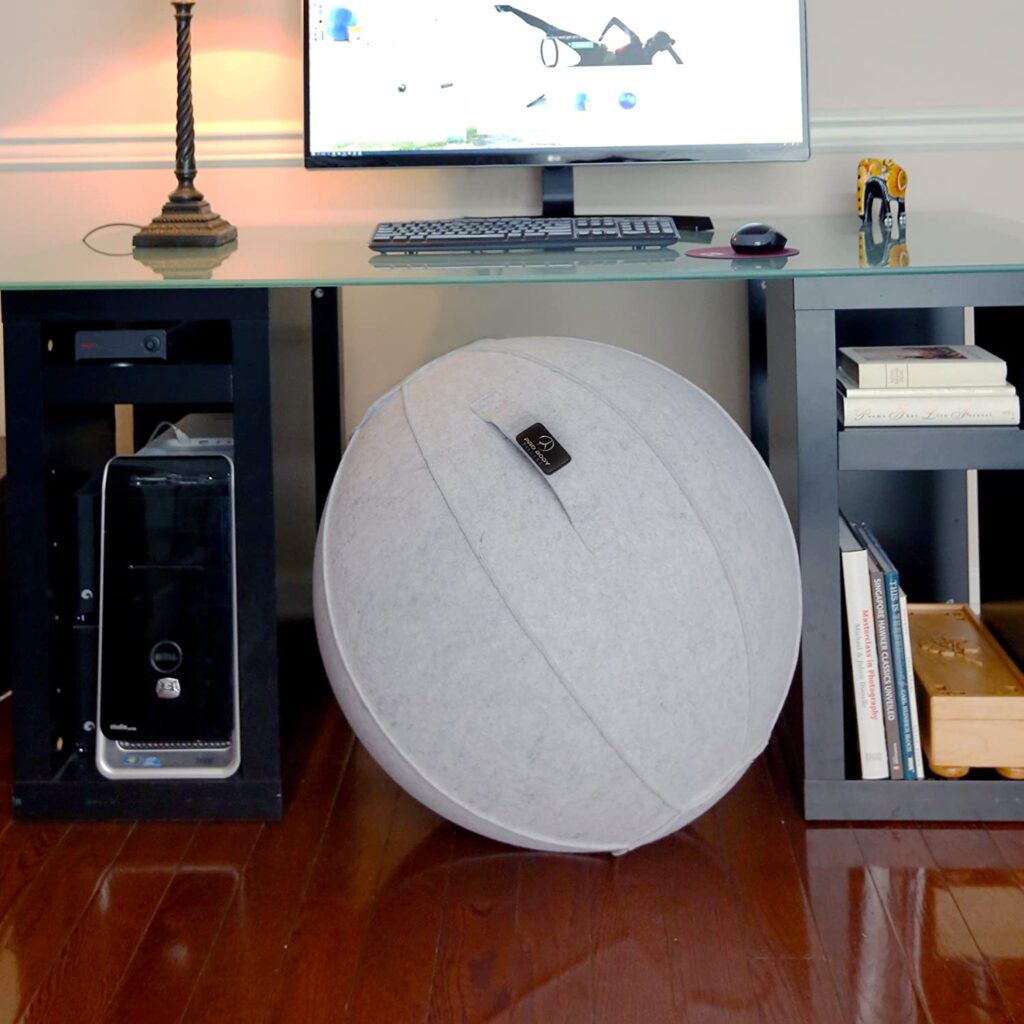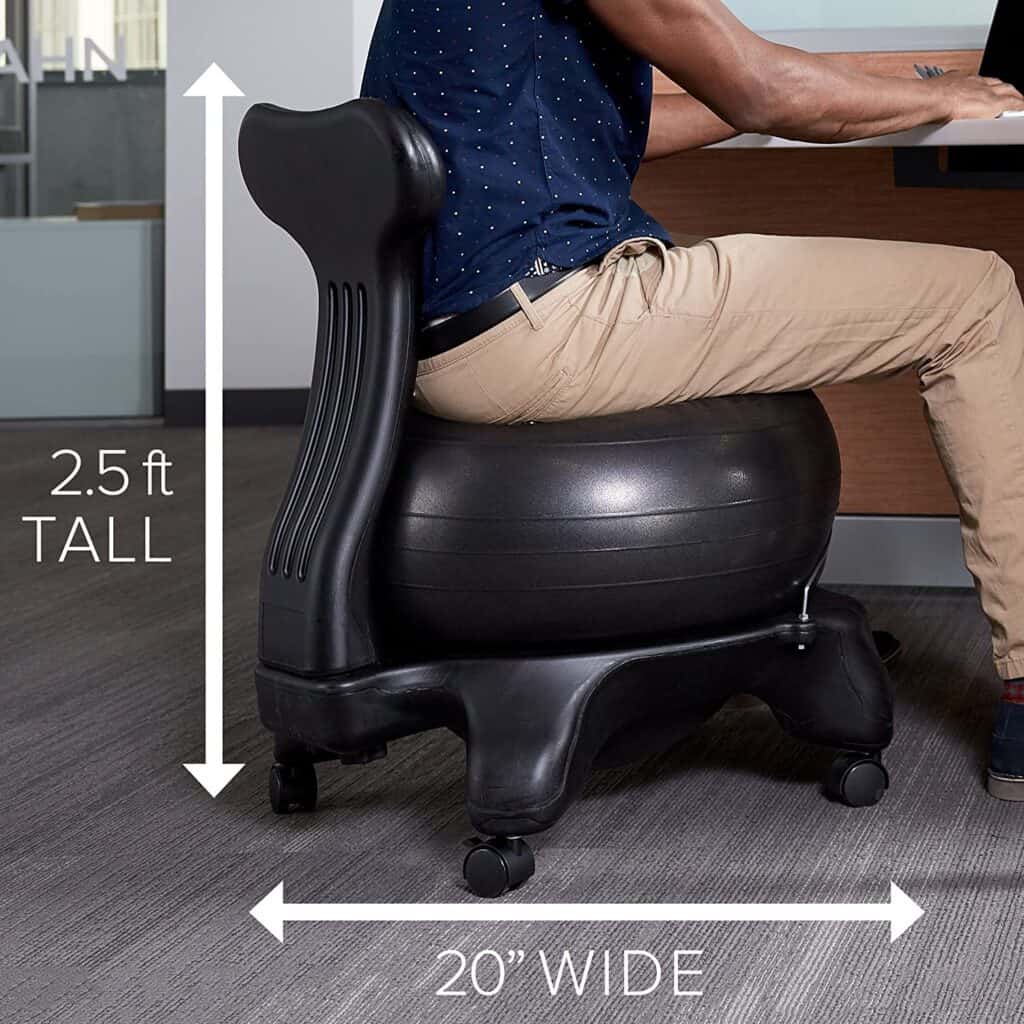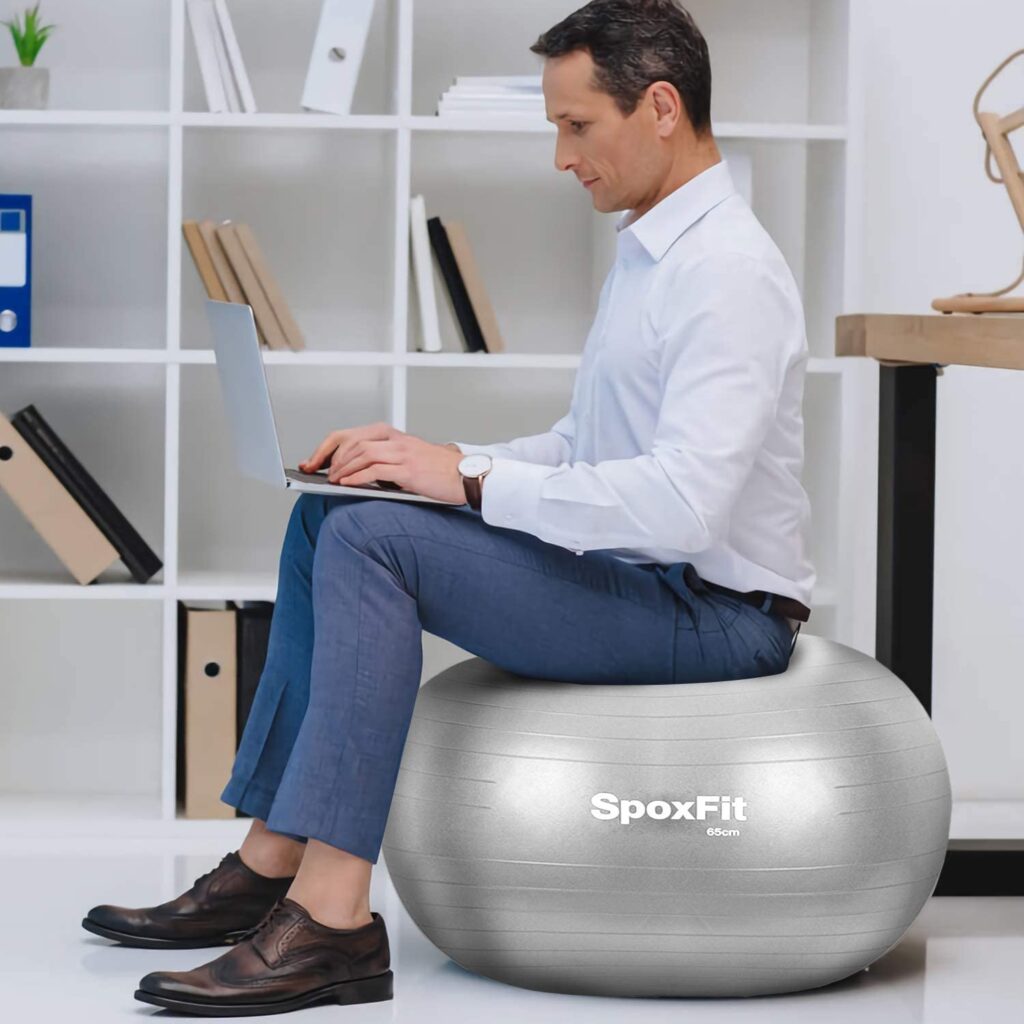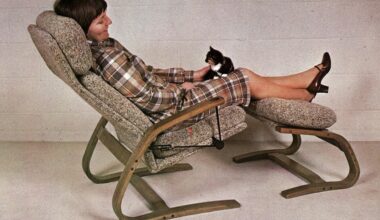Sitting for long hours in an office chair at work can be very frustrating. Prolonged periods in the office chair tighten our muscles and causes stiffness.
Replacement of regular office chairs with exercise balls helps our muscles to relax. It eventually improves our posture as well as helps to reduce back pain.
I have seen a few of my friends replacing their regular Office chair with an Exercise Ball. But what is the ideal way of sitting on an Exercise Ball?
When sitting on an exercise ball at work, straighten your back and strengthen your abdominal muscles. Place your hands on the desk to maintain muscular relaxation and increase your foot width for more stability. Set the monitor screen to your eye level to reduce neck stiffness by creating a 90-degree angle with your arms.
Always make sure that both of your elbows rest on the desk. If not, you may have to adjust the height of your desk in accordance.
Bear in mind that the height of your desk shouldn’t be too high or too low.
Read on to know more about the proper ways of sitting on an Exercise Ball while working.
Table of Contents Show
Should you Sit on an Exercise Ball When Working?
Office chairs are believed to impact our body postures negatively.
Therefore, some people choose to replace their office chairs with Exercise Balls. This gives a whole new experience at work and at the same time maintains our stability.
However, many of us are in a dilemma about whether it’s beneficial to sit on an Exercise Ball at work or not.
While sitting on an Exercise Ball, a person usually needs active engagement of the core muscles since there is no back support available on an Exercise Ball.
This encourages the user to constantly improve the body posture and core stability on their own.

However, substituting the regular office chair on your desk with an Exercise Ball for a certain period of time has its own advantages.
Now, let us discuss some pros and cons of sitting on an Exercise Ball at work.
Advantages of Sitting on an Exercise Ball at Work
Several claimed benefits of using an exercise ball include improved posture, more energy, and enhanced general balance. Let’s discuss them below in detail.
1. Burns Extra Calories
When seated on an exercise ball, you tend to engage your core muscles more than usual. This helps to burn the extra calories you have stored in your body.
Generally, trading your regular office chair with an exercise ball can help you burn out about 50 calories in an hour.
A study made in 2008 says carrying out clerical work at a desk while sitting on an Exercise Ball burned about 41.1 calories per hour than sitting on a normal Office Chair.
Substituting your regular office chairs with Exercise Balls can actually help you increase the calorie burn, but not to a great extent.
Therefore, the fact is actually real but quite small.
There is an analysis of multiple studies on this particular subject published in the June 2014 issue of the International Journal Of Obesity.
This study declares that working while sitting on an exercise ball burns the same calories as a traditional seating situation.
2. Relieves Back Pain
Sitting on an exercise ball helps you straighten your spine. It prevents you from slouching and reduces back pain.
Moreover, you can also take a few moments to stretch and relax your back muscles during work.
A case study conducted on two individuals suffering from lower back pain showed that utilizing an exercise ball as a chair at work has significantly reduced symptoms of low back pain.
3. Your Core Muscles are Toned
Exercise Balls help you to tone the core muscles. Usually, our abdominal and pelvic floor muscles require engagement.
When you balance on the exercise ball, you are encouraged to perform extra core work. This also helps to align and stabilize the spine.
The Exercise Balls are most likely to produce more muscle activities and trunk motion.
The research conducted on stability ball vs. office chair showed increased muscular activation in the thoracic erector spine and reduced pelvic tilt. It increased felt pain while sitting on the stability ball.
It may be concluded that stability balls are excellent for muscle activation but may not be suitable for long-term use.
Also read: Bean Bags for Work From Home: Is it a Good Option?
Disadvantages of Sitting on an Exercise Ball at Work
You have learned some advantages of sitting on an exercise ball at work. However, let me tell you the exercise ball is not for everyone.
In contrast, if you are more inclined to slouch forward and lean on your desk than maintain your muscles stimulated when using a balance ball, it may bring more problems, including discomfort than advantages.
Let’s look at some of the disadvantages it may impose.
1. No Back Support Increases Back Pain and Discomfort
Since Exercise Balls do not have any back support, it becomes uncomfortable to continue work.
After sitting on the Exercise Ball for a few hours, you may feel your backside sore and painful.
Sitting in an Exercise Ball at work results in more spinal shrinkage than sitting in a regular Office chair.
Moreover, it requires a lot of core strength to balance yourself comfortably in an Exercise Ball.
Keeping your core muscles engaged throughout the day without any armrest or back support makes you tired. It may eventually lead to pain in the lower back muscles and shoulders.
It will also impair your typing ability on a keyboard and execute other computer tasks.
The research also discovered that the ball did not genuinely enhance posture, and no variations in lumbar spine posture were discovered.
Also Read: Stool Vs. Chair: Which is Better for your Posture?

2. It may Cause Exhaustion
Sitting on an Exercise Ball at work all day long is difficult. Prolonged hours on the Exercise Ball result in exhaustion of your body.
Moreover, you may slide off the ball and cause injury if you are not seated properly.
According to Harvard Health Publishing, it also leads to an increase in the risk of conditions like diabetes, obesity, and cardiovascular disease.
3. Increases Fatigue
If you sit on the Exercise Ball for long hours, the lack of back support and stability can result in fatigue.
Individuals sitting the whole day on an Exercise Ball at work can develop slumping and poor posture.
A study concludes that the discomfort in posture is caused by prolonged sitting on Exercise Balls at Work.
The continual muscular activity necessary when sitting on a ball for long periods of time might induce fatigue and worsen back pain.
Fatigue can lead to bad posture, which is the opposite of why many people sit on the ball.
Research published in the December 2009 issue of “Scoliosis” discovered that those sitting on an exercise ball had identical sagging and bad posture patterns as people sitting in chairs.
4. Safety Issues
Usually, the Exercise Ball is most likely to roll out from under you. This happens if you are not careful enough. It requires effort to keep the ball in place.
Because an exercise ball chair is unstable, you risk injuring yourself if you lose your balance and fall off. You might get hurt if it breaks while sitting on it.
How to Properly Sit on an Exercise Ball at Work?
Sitting on an Exercise Ball at work for a few hours allows you freedom of movement. This usually enables you to get away from the constrained position at work to a great extent.
Before buying yourself an Exercise Ball and using it as an alternative to an office chair, it is essential to know the right method of sitting on an Exercise Ball.
Here are a few tips you should remember to use an Exercise Ball at work properly.
1. Choose the Right Sized Exercise Ball
Generally, most Exercise Balls are similar in shape and size. Therefore, you may find it difficult to select the ideal Exercise Ball for yourself.
Always make sure to consider your height before purchasing an Exercise Ball.
Here is a table you can take as a reference to get the best-sized Exercise Ball for your personal desk.
| Ball Size | Height of the Exercise Ball | Your Height |
|---|---|---|
| Small | 45 cm | Up to 4'10" (145cm) |
| Medium | 55 cm | 4'8" to 5'5" (140 - 165cm) |
| Large | 65 cm | 5'6" to 6'0" (165 - 185cm) |
| Extra large | 75 cm | 6'0" to 6'5" (185 - 195cm) |
Make sure you buy a ball that has anti-burst technology.
2. Consider the Height of the Desk
Make sure to rest your elbows on the desk. The screen of your monitor should be adjusted to the eye level.
You may adjust the desk height if your elbows do not rest on the desk. If the desk is too low, you will need to stretch your arms to get the keyboard.
In this case, you may hunch over, ruining your body posture. Sitting in an incorrect position in an exercise ball results in arm and shoulder pain.

3. Inflate the Exercise Ball to the Right Degree of Firmness
You should inflate the ball as long as you can sit on it with your feet resting on the floor.
Make sure your legs form a 90-degree angle right to the floor. To inflate your exercise ball, you may use any air pump.
Air mattress pumps, reversing vacuum cleaners, and air compressors are the most effective. Handheld pumps can be utilized, although they are ineffective.
Tips for Properly Inflating the Exercise Ball
- If it is below 20 degrees Celsius, do not overinflate your ball. Before inflating, bring to room temperature (20 degrees or above).
- First, inflate the ball to around 80% of its original diameter. Wait another 24 hours before inflating to the appropriate size.
- You should not use the ball for the first 24 hours.
- Place the box on the entire circle of the exercise ball as measured from the wall. Remove the valve and inflate the ball completely.
- Replace the valve as soon as the ball contacts both the wall and the box.
The optimum exercise ball size is determined by diameter rather than pressure. Do not inflate the ball beyond the recommended size.
4. Right Body Positioning
Make sure to relax your shoulders and straighten your back. Generally, your arms form a 90-degree angle while placing your hands on the desk.
Tighten your abdomen and widen your feet to create stability. You can place your calves in front of you and make sure they touch the ball.
The pelvis, shoulder, and ears should be in a vertical line. Maintain a hip-width distance between your knees. Keep both feet on the ground.
Straighten your spine and roll your shoulders back, so your neck is not bent. While working and sitting on the ball, adjust your computer screen or monitor to eye level to avoid neck or shoulder strain.
You may need to change the location of your keyboard and computer. Make minor circular or side-to-side motions with your buttocks and back as you sit to keep your abs active.

5. Practice Active Sitting
You can also practice active sitting by going for a quick workout in between. Strengthen your abs, arms, and legs during your breaks.
People who use an Exercise Ball frequently practice shoulder presses, knee extensions, pilates, and abdominal crunches.
You can also flex the muscles in your abdomen as an extra element of exercising.
Although simply sitting on the exercise ball stimulates your core muscles, you can also strengthen your abs, arms, and legs during your breaks for a quick exercise.
6. Take Frequent Breaks
Continuously working for too long hours on an Exercise Ball is not really good for your physical health and wellbeing.
If you sit for too long hours without taking any breaks in between, your muscles become fatigued.
You may also experience some soreness in your lower and middle back.
Use the exercise ball for no more than 20 minutes and alternate between an ergonomic office chair.
How Long should you Sit on an Exercise Ball at Work?
Do not sit on Exercise Balls at work for more than 30 minutes at a time.
It is absolutely okay to swap your office chair with an Exercise Ball, but staying on it for a long time is not considered healthy.
If you sit on an Exercise Ball for too long, you will gradually start experiencing body aches and pain in the muscles.
The research suggested the minor differences in biological reactions when sitting on a stability ball vs. an office chair, together with the increased reported pain.
At the same time, the ball, imply that its usage for prolonged sitting may not be beneficial.
Prolonged sitting on a stability ball does not appear to change how an individual sits, but it does appear to raise the amount of pain.

The Bottom Line
Sitting on an exercise ball has its own advantages and disadvantages.
Substituting your normal office chair with an Exercise Ball for a certain period of time does no harm. However, prolonged sitting on an Exercise Ball may cause instability. Sometimes it may even lead to injuries.
With proper precautions and care, you can have a newer experience at work, sitting on an Exercise Ball.
Despite the few cons, people widely use Exercise Balls in their workspaces. You will need to be cautious not to use it for too long hours continuously.
Related Article: 10 Best Office Chair Alternatives


